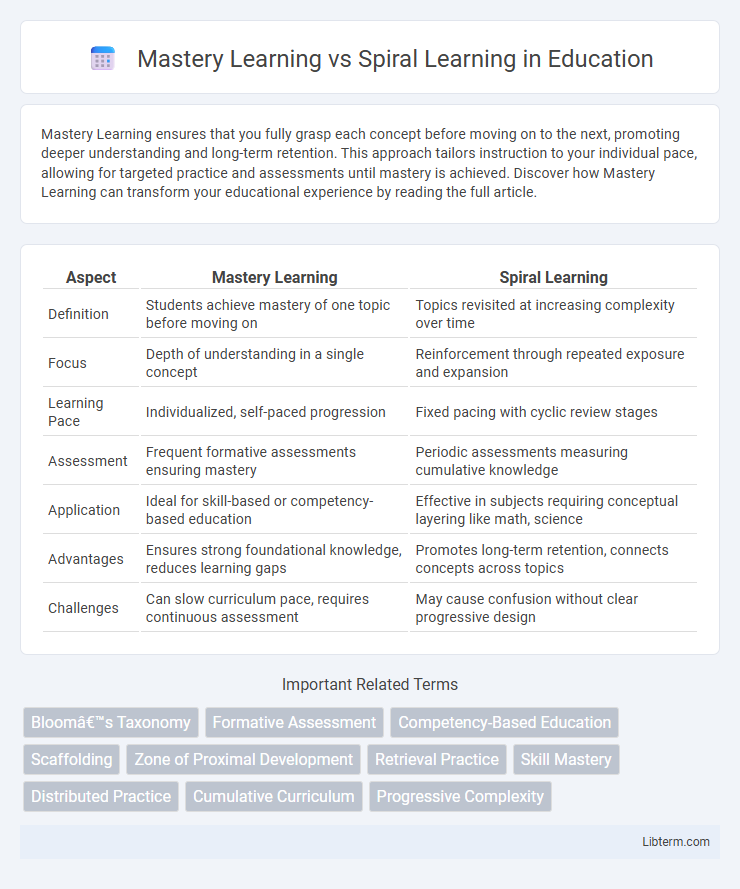Mastery Learning ensures that you fully grasp each concept before moving on to the next, promoting deeper understanding and long-term retention. This approach tailors instruction to your individual pace, allowing for targeted practice and assessments until mastery is achieved. Discover how Mastery Learning can transform your educational experience by reading the full article.
Table of Comparison
| Aspect | Mastery Learning | Spiral Learning |
|---|---|---|
| Definition | Students achieve mastery of one topic before moving on | Topics revisited at increasing complexity over time |
| Focus | Depth of understanding in a single concept | Reinforcement through repeated exposure and expansion |
| Learning Pace | Individualized, self-paced progression | Fixed pacing with cyclic review stages |
| Assessment | Frequent formative assessments ensuring mastery | Periodic assessments measuring cumulative knowledge |
| Application | Ideal for skill-based or competency-based education | Effective in subjects requiring conceptual layering like math, science |
| Advantages | Ensures strong foundational knowledge, reduces learning gaps | Promotes long-term retention, connects concepts across topics |
| Challenges | Can slow curriculum pace, requires continuous assessment | May cause confusion without clear progressive design |
Introduction to Mastery Learning and Spiral Learning
Mastery Learning emphasizes achieving a high level of understanding in one topic before progressing to the next, ensuring students demonstrate proficiency through formative assessments and targeted feedback. Spiral Learning revisits key concepts repeatedly over time, building complexity with each iteration to reinforce retention and deepen comprehension. Both methods aim to enhance learning outcomes by structuring content delivery to support long-term mastery and cognitive development.
Core Principles of Mastery Learning
Mastery Learning emphasizes achieving a high level of understanding in one topic before moving to the next, ensuring students master foundational concepts thoroughly. It involves personalized pacing, formative assessments, and targeted feedback to address learning gaps effectively. This approach contrasts with Spiral Learning, which revisits topics periodically with increasing complexity rather than complete mastery at each stage.
Key Concepts of Spiral Learning
Spiral learning emphasizes revisiting key concepts repeatedly over time, allowing learners to build deeper understanding through progressive complexity. Core ideas include reinforcement of prior knowledge, integration of new information with existing schemas, and scaffolding that supports long-term retention. This approach contrasts with mastery learning by promoting continuous review and connection of concepts rather than achieving complete mastery before moving forward.
Differences Between Mastery and Spiral Learning
Mastery learning emphasizes complete understanding of a topic before moving on, ensuring students achieve a high level of competency in each unit. Spiral learning revisits concepts periodically, reinforcing knowledge through repeated exposure while progressively increasing complexity. The key difference lies in mastery learning's focus on proof of proficiency at each stage versus spiral learning's cyclical approach to content reinforcement.
Benefits of Mastery Learning
Mastery learning ensures students achieve a high level of understanding before progressing, resulting in stronger foundational knowledge and reduced learning gaps. This approach promotes individualized pacing and allows for targeted instruction tailored to each student's needs, enhancing retention and confidence. Evidence shows mastery learning increases academic achievement, leading to higher test scores and long-term mastery of complex skills.
Advantages of Spiral Learning
Spiral learning reinforces knowledge retention by revisiting topics at increasing levels of complexity, allowing learners to build deeper understanding over time. This method supports long-term memory consolidation and adapts to individual learning paces, promoting continuous improvement. Its cyclical approach reduces cognitive overload by breaking down complex subjects into manageable, interconnected segments.
Challenges in Implementing Mastery Learning
Mastery Learning faces challenges such as the need for extended instructional time and individualized pacing, which can strain classroom resources and teacher workload. Difficulty in maintaining student motivation during repetitive practice sessions and assessments often slows progress, impacting overall engagement. Ensuring consistent mastery across diverse learners requires robust formative assessments and adaptive instructional strategies, complicating implementation in heterogeneous classrooms.
Obstacles in Adopting Spiral Learning
Spiral learning presents challenges such as increased curriculum complexity and demands on teacher expertise to revisit topics at progressively deeper levels, which can hinder seamless implementation. Schools often struggle with resource allocation and scheduling to accommodate multiple iterations of subjects, leading to potential student confusion if foundational knowledge is not reinforced effectively. Overcoming these obstacles requires targeted professional development and adaptive instructional design to ensure consistent mastery throughout the learning spirals.
Choosing the Right Approach for Your Classroom
Choosing the right approach between Mastery Learning and Spiral Learning depends on your classroom goals and student needs. Mastery Learning emphasizes achieving a deep understanding of one concept before moving on, ideal for subjects requiring foundational skills such as math and languages. Spiral Learning revisits topics periodically, reinforcing knowledge and fostering long-term retention, which suits curricula focusing on cumulative skill development and interdisciplinary connections.
Future Trends in Educational Learning Models
Mastery learning emphasizes complete understanding of one topic before progressing, ensuring skill retention and competency, while spiral learning revisits concepts with increasing complexity to deepen knowledge over time. Emerging trends in educational models are integrating adaptive technology and AI-driven platforms to personalize mastery pathways and cyclic spirals, optimizing student engagement and learning outcomes. Future developments aim to blend these approaches with immersive virtual environments to support continuous, scaffolded learning tailored to individual cognitive growth trajectories.
Mastery Learning Infographic

 libterm.com
libterm.com